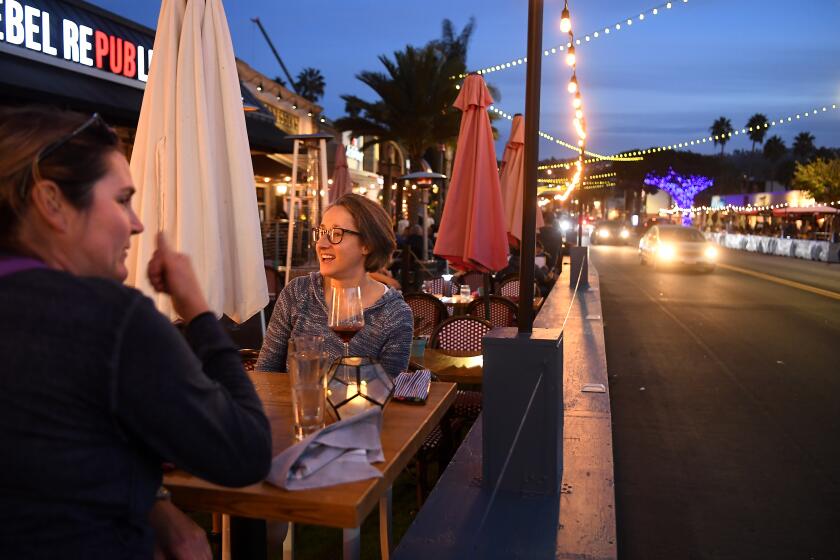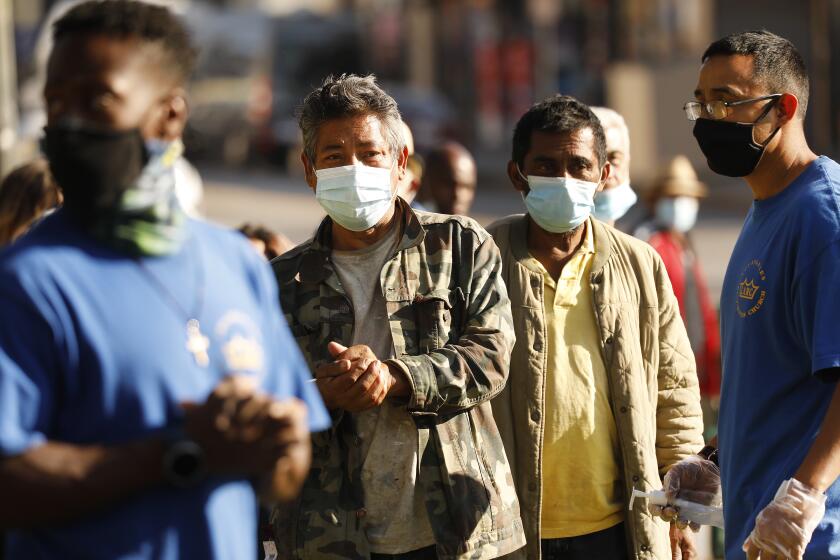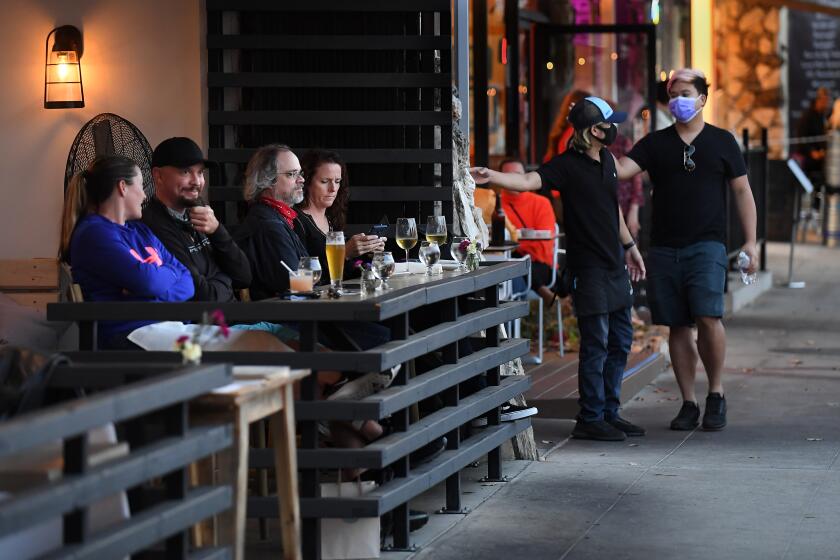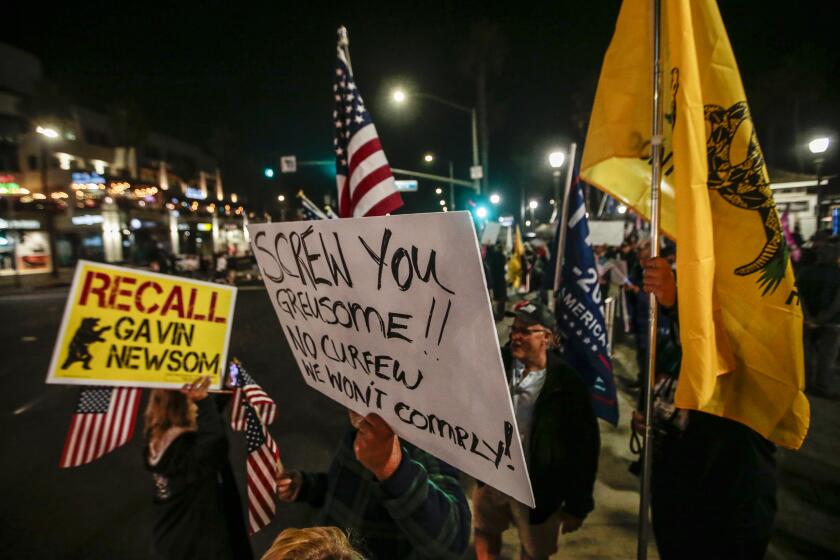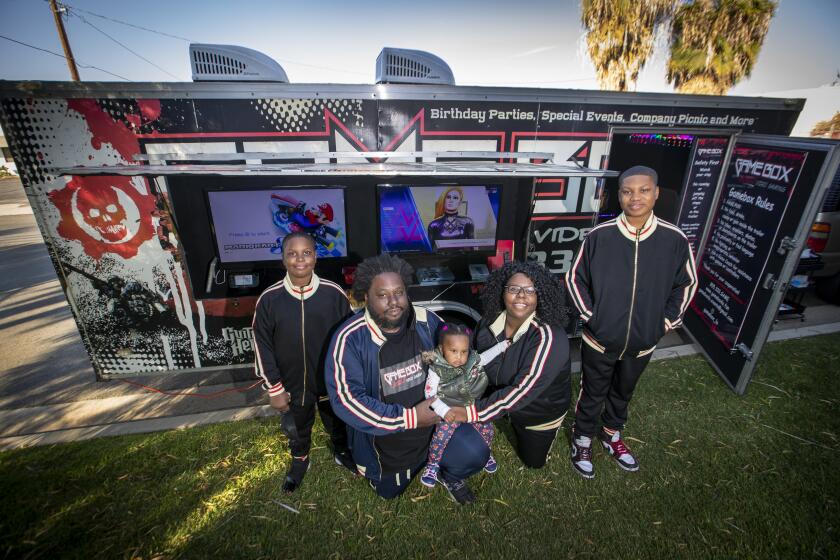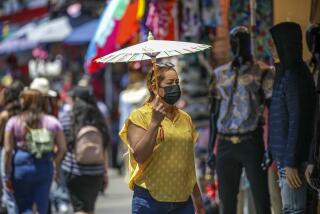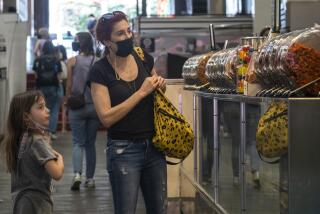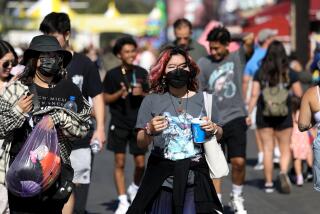L.A. outdoor dining ban survives challenges as COVID-19 outlook worsens
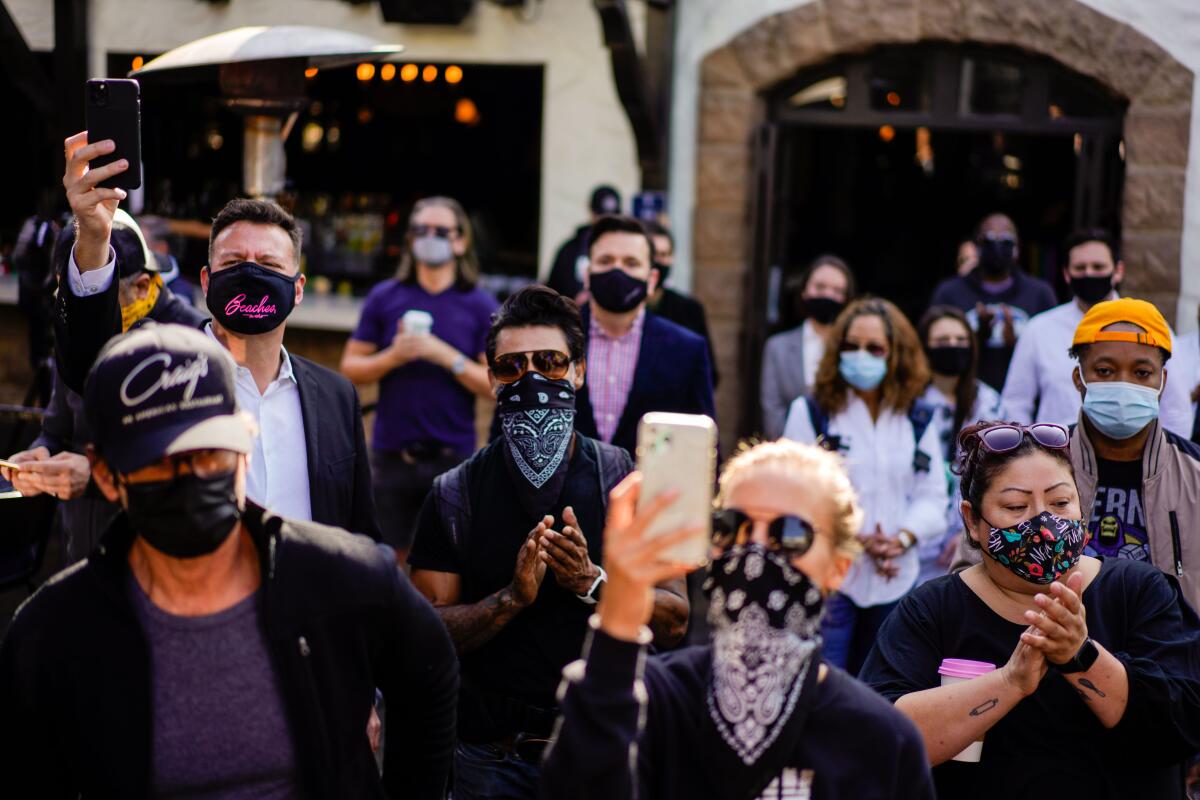
With coronavirus cases continuing to soar across the state, a divided Los Angeles County Board of Supervisors rejected calls Tuesday to walk back restrictions on outdoor dining meant to slow the virus’ rapid spread.
The political friction over the decision by health officials to clamp down on restaurants and bars played out as the state once again shattered its record for new coronavirus cases and the number of Californians dying from COVID-19 continued to climb on a trajectory that is expected to continue in the coming weeks, the state’s health secretary said Tuesday.
Earlier this week, L.A. County officials announced they would ban for at least three weeks all in-person dining and restrict restaurants ‚ÄĒ along with breweries, wineries and bars ‚ÄĒ just to takeout and delivery service beginning at 10 p.m. Wednesday. The announcement came after the county‚Äôs five-day average of new coronavirus cases topped 4,000, a threshold officials had set for implementing the restriction.
Gov. Gavin Newsom has announced a stay-at-home order affecting most of California.
The move was met with anger and desperation from restauranteurs, who have been reeling from the pandemic. Outdoor dining offered a lifeline, and many owners and workers felt they were doing everything they could to keep their establishments safe.
Others questioned the wisdom or efficacy of the restriction, and demanded to see the data justifying such a move.
The objections gained enough momentum to make their way to the five-member county board, which took up the dining ban at its meeting Tuesday and considered an emergency proposal to roll it back, even though county health officials had said it was necessary.
The decision to suspend outdoor dining came as Los Angeles County recorded its highest one-day total for COVID-19 cases on Monday.
Supervisor Kathryn Barger, whose Fifth District includes Santa Clarita and much of north L.A. County, said the suspension ‚Äúwill punish a sector that is unfairly shouldering the burden‚ÄĚ ‚ÄĒ and added that she‚Äôs ‚Äúconcerned that this county has taken the approach of everything should be closed, unless we have a good reason to open it.‚ÄĚ
‚ÄúI feel that what is happening today is truly going to devastate not only the workers but their families,‚ÄĚ she said. ‚ÄúAnd I cannot in good conscience support something that cannot be supported by data.‚ÄĚ
Both Barger and Supervisor Janice Hahn questioned whether the dining ban was necessary and put forth a proposal that called for the board to keep in place the current restrictions , which allow restaurants and bars to fill half of their outdoor seating until 10 p.m.
The motion was voted down, with Supervisors Sheila Kuehl, Hilda Solis and Mark Ridley-Thomas opposing it.
They chose to stick with the dining ban after hearing from county health officials who said that although it was hard to say for certain how much in-person dining has contributed to the surge in cases, it was clear that people gathering with others outside their immediate families and removing their masks to eat increased the risk of new infections.
‚ÄúThis is the only business that allows its customers to remain, and often for quite a while, unmasked,‚ÄĚ Kuehl said . ‚ÄúAnd that, I think, is enough so single it out right there. We tried, but the numbers have gone up.‚ÄĚ
Solis, whose First District includes some of the hardest-hit communities in East L.A., urged her colleagues to listen to the public health experts.
‚ÄúWe will see the true impact in terms of hospitalizations, maybe not in this minute, but for sure, in the next two or three weeks,‚ÄĚ she said.
Solis said she was at a private hospital over the weekend because her mother had a health issue and was alarmed at what she saw.
‚ÄúI‚Äôve never in my life seen the corridors in the ER completely full,‚ÄĚ Solis said. ‚ÄúThere were no rooms available to treat COVID patients. That to me was very startling.‚ÄĚ
Whatever side of the debate they fell on, though, it was clear supervisors hadn’t anticipated having to face the prospect of additional measures so soon.
Hahn, whose Fourth District includes several beach cities, said when the board agreed with the restrictions put forth by the Public Health department during closed session last week, she thought L.A. County was ‚Äúweeks away‚ÄĚ from hitting those metrics.
‚ÄúI honestly had hoped with our first six recommendations we put into place we could avoid getting to this point,‚ÄĚ Hahn said.
The chorus of objectors included the Los Angeles City Council, which voted 11 to 3 Tuesday to seek a repeal of the outdoor dining restrictions ‚ÄĒ saying they would trigger a new round of restaurant closures.
‚ÄúThis will be the final nail in their coffin,‚ÄĚ said Councilwoman Monica Rodriguez, who led the push.
Some council members said county officials had failed to produce a scientific rationale for seeking a halt to outdoor in-person dining. Others said they believed the steady increase in COVID-19 cases was linked to other factors, such as residents holding neighborhood barbecues or worshipping indoors.
Councilman Mike Bonin, who cast a dissenting vote along with members Marqueece Harris-Dawson and Curren Price, said some restaurants have set up outdoor dining areas with barriers so significant that their patrons are effectively experiencing indoor dining
He also argued that the council, which lacks its own health department, does not have a team of experts to guide them on their decision.
‚ÄúSince we don‚Äôt have the scientists ‚Ķ I would prefer to think that we would defer to the county, which is in charge of the issue,‚ÄĚ he said.
The new wave of coronavirus cases brings L.A. County closer to another stay-at-home order.
L.A. County, like the state as a whole, is wrestling with an avalanche of coronavirus cases that officials warn will lead to increased levels of hospitalizations and deaths.
‚ÄúCertainly, the numbers of deaths will likely go up. Just as we are exceeding our highest-ever numbers of cases, and beginning to see our hospital systems pressed with COVID beyond where they‚Äôve ever been pressed before, the idea that the numbers of deaths could exceed where we‚Äôve been before is also real and true,‚ÄĚ Dr. Mark Ghaly, the California health and human services secretary, said on Tuesday.
The state recorded 20,654 cases Monday, easily surpassing the previous high of 13,400 infections. L.A. County announced more than 6,000 new cases, which was also a daily record.
‚ÄúWe are truly in the midst of a surge here in California,‚ÄĚ Ghaly said.
Statewide, the daily average of new coronavirus cases, calculated over a seven-day period, more than doubled in the past two weeks. Most of California’s counties also reported the same doubling or worse.
In southeastern California, Imperial County has seen its daily average of coronavirus cases nearly quadruple in the last two weeks. That county has been forced to erect a 50-bed tent to help deal with a surge in COVID-19 patients and has requested dozens of additional healthcare workers, including 33 intensive care unit nurses, three lab scientists, 21 emergency room nurses and six respiratory therapists, officials said last week.
Imperial County has also seen its coronavirus test positivity rate double in the course of a month, from 10.5% to 23.8%.
Between Nov. 1 and Monday, the number of people hospitalized with COVID-19 statewide has more than doubled, Ghaly said, from about 2,500 to more than 5,800. Some hospitals‚Äô intensive care units ‚Äúare already being pressed to a significant degree,‚ÄĚ he added.
‚ÄúWhen you see the numbers more than double in just under three weeks, we‚Äôre concerned,‚ÄĚ Ghaly said.
A judge rejected a plea by a restaurant group to block the ban on outdoor dining amid surging coronavirus cases.
The massive rise in new infections has moved the state into uncharted territory, far beyond the number of new infections the state was tallying just a few weeks ago.
During the five-day period ending Oct. 23, California recorded 24,263 total new coronavirus cases, according to data compiled by The Times. Over the last five days, there have been 65,168 cases.
The percentage of tests being performed that are coming back positive for the coronavirus ‚ÄĒ a benchmark referred to as the test positivity rate ‚ÄĒ has dramatically increased by more than 50%. More than 5.5% of tests for the 14-day period ending Tuesday were positive, up from 3.7% two weeks ago.
The skyrocketing case count is the latest sign that California has entered a critical moment just ahead of the Thanksgiving holiday.
‚ÄúRecords are being shattered by the number of people whose lives are being shattered by COVID-19,‚ÄĚ L.A. Mayor Eric Garcetti said Monday.
Officials are hoping that restrictions imposed over the last week will slow the unprecedented spread of the virus and that residents will avoid big Thanksgiving gatherings that experts fear will further fuel infections.
‚ÄúThere‚Äôs too much transmission happening here right now in this county ‚ÄĒ too much transmission with too many meetings of too many people,‚ÄĚ Garcetti said during a briefing. ‚ÄúSo the solution is simple; we know it, and we can do it: Stay away from each other. Assume everybody you would see is infectious and, please, let us not make this Thanksgiving the deadliest day of this pandemic.‚ÄĚ
Last week, state officials announced a new order prohibiting most nonessential activity outside the home from 10 p.m. to 5 a.m. in counties in the strictest ‚Äúpurple‚ÄĚ tier of the state‚Äôs color-coded reopening road map. Roughly 95% of Californians ‚ÄĒ including all those in the southern third of the state ‚ÄĒ are subject to that order, which lasts until Dec. 21, though it could be extended.
‚ÄúWe‚Äôre hoping that‚Äôs all we‚Äôll need, but we‚Äôll see,‚ÄĚ Gov. Gavin Newsom said Monday. ‚ÄúWe‚Äôre open-minded to the dynamics of the conditions that are changing in real time.‚ÄĚ
Amid pandemic fatigue, people are questioning the new California COVID-19 lockdown measures. Experts say these rules could help slow the infection rate.
As the wave of new cases climbs, officials warn that it will eventually crash down on the healthcare system. Authorities have estimated that about 12% of cases will end up in a hospital in two to three weeks ‚ÄĒ a potentially unmanageable number of patients, should the number of cases remain high.
Last week, officials in L.A. County warned that hospitals were in danger of being overwhelmed. Garcetti said Monday that, ‚Äúat this rate, our hospitals won‚Äôt have any spare beds by Christmastime.‚ÄĚ
‚ÄúLos Angeles is on a very dangerous path,‚ÄĚ he said. ‚ÄúAnd if we don‚Äôt make changes soon to our day-to-day lives, we‚Äôll have more infections, more suffering, more hospitalizations and, yes, more death.‚ÄĚ
L.A. County residents are already dying from COVID-19 at an increasing pace. A recent Times analysis found that an average of 26 deaths were reported every day over a seven-day period, more than double the number experienced in early November.
At this pace, California as a whole will see its cumulative death toll double just before spring, from the more than 18,700 deaths currently tallied to over 37,000 by March 1, according to model forecasts by the University of Washington’s Institute for Health Metrics and Evaluation.
Amid the worsening surge, L.A. County is moving closer to another shutdown.
Officials said last week that if the average number of new daily coronavirus cases over a five-day period reached 4,500, it would trigger some kind of new stay-at-home order for at least three weeks.
Monday‚Äôs record number of reported cases was enough to push the county past that average. What precise form that new order will take, however, is unclear at this point. L.A. County‚Äôs director of public health, Barbara Ferrer, on Monday said, ‚ÄúFor sure, we‚Äôre not going back to all of the restrictions that were in place in the original Safer at Home order.‚ÄĚ
She described proposed restrictions that would be less encompassing than those issued in March. It’s unnecessary to be as broad, she suggested, because officials know more about the virus and testing capacity has improved. The specifics will be discussed Tuesday with the five-person Board of Supervisors, which represents the county’s 10.1 million residents.
The lucky among California‚Äôs small businesses have cobbled together loans and grants to get through the pandemic so far. But that money has dried up, and ‚Äúyou can only take on so much debt.‚ÄĚ
The severity of the current spike has already brought about significant new restrictions at the county and state levels.
Ahead of Thanksgiving, California issued a travel advisory urging residents not to travel out of state for the holiday, and recommending that those who do quarantine for 14 days when they return.
Starting Wednesday, travelers at the Los Angeles International and Van Nuys airports, as well as at Union Station, will need to fill out an online form prior to or upon arrival acknowledging the advisory, Garcetti said.
Garcetti, however, urged all Angelenos to stay home as much as possible until the surge subsided.
‚ÄúIf everyone abides by these rules, if everyone takes these seriously ‚ÄĒ these small but critical sacrifices ‚ÄĒ we will get through this,‚ÄĚ he said. ‚ÄúWe‚Äôre not asking you to take up arms and to go overseas to fight a war. We‚Äôre not looking at some of the sacrifices that have been made by generations before us. We‚Äôre just asking for you to stay home.‚ÄĚ
Times staff writer David Zahniser contributed to this report.
More to Read
Sign up for Essential California
The most important California stories and recommendations in your inbox every morning.
You may occasionally receive promotional content from the Los Angeles Times.

